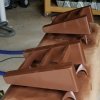I am in a position where I could benefit from selling stuff and since I own so much audio gear, I am looking into that.
Recently I worked on a project for a partner using some coaxial speakers and thought they were amazing, especially for the price. As it turned out, the first two speaker the supplier sent me were damaged in shipping and they immediately sent me a replacement set which arrived fine. When I asked about them, I was told to just keep the damaged speakers, which I did thinking I’d use them for photography for non-functioning trade show models. I discovered that I could repair them with some considerable effort and time, and I sat about doing that. It was quite difficult and took much longer than I anticipated, but in the end, I was able to restore them to working order.
I then had a set of working coaxial speakers which in a utility design sounded very good. I wondered how they could sound if I designed an over the top audiophile setup for them – so that’s what I did.
The finished system sounds stunning, and every bit as good as, and likely better than, the SVS MBS-01 speakers they are replacing.
Below is a bunch of photos of the design, build, and results for you to look over. Feel free to ask any questions you might have. Note that I cut costs at every point where I could because, after all, I need to cash from selling the SVS bookshelves to pay bills.

Drawing of the design I decided to build. I wanted to use as much MDF as possible in place of more costly parts like flared ports or fancy input cups.

My enclosure modelling software predicted a solid bass response with no ringing down to about 55Hz with a bass limit of about 43Hz.

The predicted impedance curve was pretty good for the driver and should be easy for the amp to drive.
Recently I worked on a project for a partner using some coaxial speakers and thought they were amazing, especially for the price. As it turned out, the first two speaker the supplier sent me were damaged in shipping and they immediately sent me a replacement set which arrived fine. When I asked about them, I was told to just keep the damaged speakers, which I did thinking I’d use them for photography for non-functioning trade show models. I discovered that I could repair them with some considerable effort and time, and I sat about doing that. It was quite difficult and took much longer than I anticipated, but in the end, I was able to restore them to working order.
I then had a set of working coaxial speakers which in a utility design sounded very good. I wondered how they could sound if I designed an over the top audiophile setup for them – so that’s what I did.
The finished system sounds stunning, and every bit as good as, and likely better than, the SVS MBS-01 speakers they are replacing.
Below is a bunch of photos of the design, build, and results for you to look over. Feel free to ask any questions you might have. Note that I cut costs at every point where I could because, after all, I need to cash from selling the SVS bookshelves to pay bills.

Drawing of the design I decided to build. I wanted to use as much MDF as possible in place of more costly parts like flared ports or fancy input cups.
My enclosure modelling software predicted a solid bass response with no ringing down to about 55Hz with a bass limit of about 43Hz.

The predicted impedance curve was pretty good for the driver and should be easy for the amp to drive.

























